James Payne heads to Bilbao to see the collection of Hermann and Margrit Rupf. Ordinary people who just happened to have extraordinary tastes.
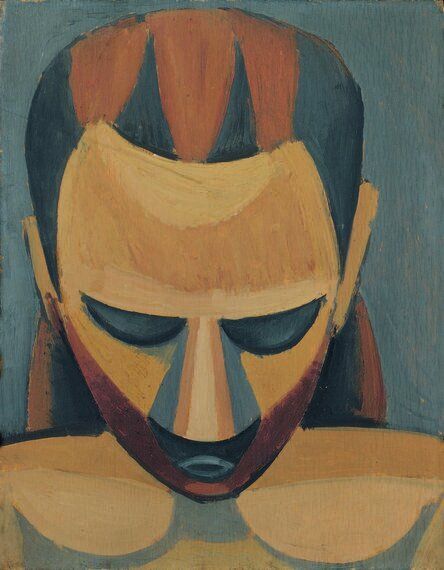
Pablo Picasso, Tête d'homme, 1908
Oil on wood
Hermann und Margrit Rupf-Stiftung, Kunstmuseum Bern
© Sucesión Pablo Picasso, VEGAP, Madrid, 2016
From the Borghese and Farnese, through to Thyssen and Tate and right up to Saatchi and Zabludowicz, private collectors have shaped the world of art.
Some collectors like David Roberts and Frank Cohen open up their own spaces whilst others bequeath their works to the nation, as did Robert Lehman at the Met and Richard Wallace with The Wallace Collection. In recent news Elton John generously agreed to donate his extensive photography collection to the Tate.
But there are also collectors of more humble means. Ordinary people with extraordinary tastes, like civil servants Herbert and Dorothy Vogel in the US, and Hermann and Margrit Rupf, owners of a haberdasheries in Switzerland, who amassed incredible collections.

From left to right: Margrit Rupf-Wirz, Daniel-Henry Kahnweiler, unidentified woman, and Hermann Rupf in Mürren, ca. 1945. Unknown photographer, Rupf Archive, Kunstmuseum Bern.
Hermann Rupf died in 1962 with 250 works in his collection. Now the Rupf collection is 900 strong and growing and the Guggenheim in Bilbao is showing 70 of the masterpieces. Many of the 70 works are key turning points in the history of abstract art, by Pablo Picasso, Georges Braque, Juan Gris, Fernand Léger, Paul Klee, and Vasily Kandinsky. The Rupfs were close friends with Kandinsky and Klee, who gave them dedicated works on birthdays and Christmas. Almost all the works were bought the same year they were created and Hermann Rupf was personally involved with many of the artists, if not at the beginning of their careers, then at a pivotal time.
Just one year after Rupf's death, the Foundation bought Henri Laurens's 1918 work Fruit Bowl and Pipe. This policy continues to this day with The Rupf Foundation still buying new works to add to the core of the art collection that the couple amassed over their lifetime. Amongst the works bought since Rupf's death (many on display here) are works by Donald Judd, Joseph Beuys, Meret Oppenheim, James Turrell and many others.
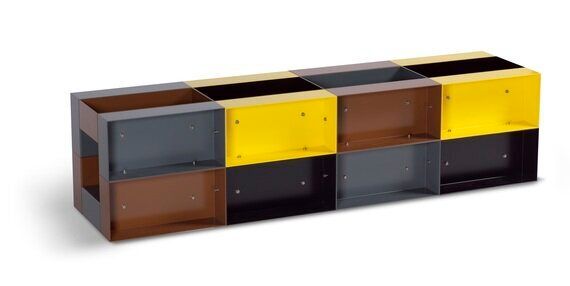
Donald Judd, Untitled, no. 85-065, 1985
Aluminum, 30 x 120 x 30 cm
Hermann und Margrit Rupf-Stiftung, Kunstmuseum Bern
© Donald Judd, VEGAP, Bilbao, 2016
On Rupf's business trips to Paris to buy fashion accessories for his haberdashery shop, he would meet with his good friend, the gallerist, Daniel-Henry Kahnweiler and join him on his visits to artists. As early as 1907, Rupf began to purchase works by Pablo Picasso and Georges Braque, and by Fauvists, such as Othon Friesz and André Derain.
His initial purchases are the first you see as you enter the exhibition, by the Fauvist painter André Derain. Kanhweiler had bought Derain's entire studio and Rupf bought several, including the extraordinary Landscape near Cassis from 1907. Many of the concerns of Fauvism are here, with the first steps towards abstraction, the use of bold complimentary colours and loosely applied dabs of paint. Rupf struck artistic gold with his first works, buying paintings by artists the critics had derided as Les Fauves ("The wild beasts").
Rupf had an almost Zelig-like knack of being in the right place at the right time. He pops into Picasso's studio and buys a 1907 gouache, and Head of a Man in 1908, two transitionary images following Picasso's visit to the famous African art exhibition in 1907. This is the same year Picasso drew his first designs for what became Les Demoiselles d'Avignon and we can only speculate as to whether the first brush strokes for that revolutionary painting were on the easel in Montmartre as Rupf paid a visit. At the same time he picks up Houses at Estaque by Braque in 1908, considered to be the first cubist painting.
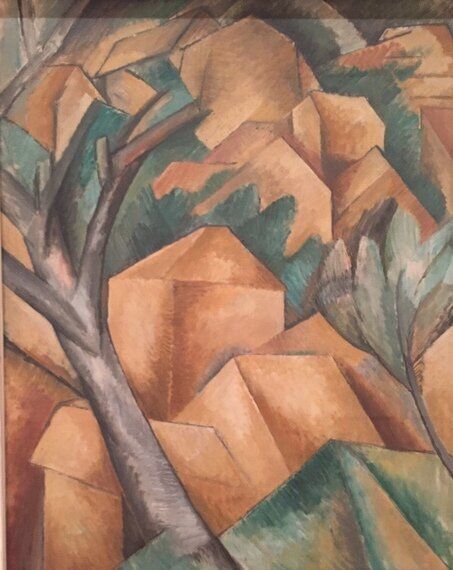
Georges Braque, Maisons à l'Estaque, 1908
Oil on canvas
Hermann und Margrit Rupf-Stiftung, Kunstmuseum Bern
© Sucesión Georges Braque, VEGAP, Madrid, 2016
1913 was the year the Armory show in New York brought modern art into mainstream popular culture. It was a good year too for Rupf when he buys Fernand Léger's iconic Contrasts of Forms, which pulls art even further away from its traditional role of representation, and Picasso's Violin Hanging on the Wall (1913), the work that crystallized Picasso's brand of Cubism and was part of his vocabulary right into the 1920s.
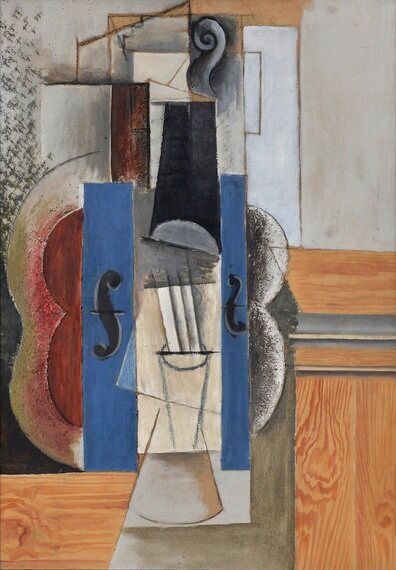
Pablo Picasso, Un violin accroche au mur, 1913
Oil on canvas
Hermann und Margrit Rupf-Stiftung, Kunstmuseum Bern
© Sucesión Pablo Picasso, VEGAP, Madrid, 2016
Incredible for any collector to own so many important pieces but remember Rupf is buying them as they are created, not in retrospect.
Many of the works in this show are important pieces of art history, and can be read in relation to each other. But the show is not totally chronological, and in a clever piece of curation the show liberally dips into the post 1962 collection. The first time it is used is a lovely surprise when a Gotthard Graubner is shown next to several Derain, seemingly the only reference being colour.
One example of a literal intervention is when in 1972 the Rupf institute invited Florian Slotawa, a Berlin-based artist who frequently recontextualises existing objects, to work with the collection. The Rupf family furniture becomes the plinths upon which rest pieces taken directly from the collection, including a Hans Arp sculpture. This is one of my favourite pieces, which playfully questions what is the actual piece? The plinths? Or the artworks on them?
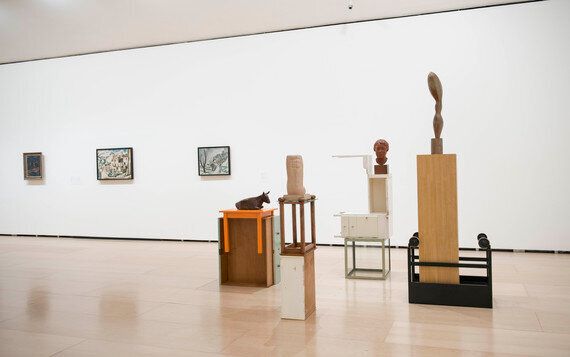
Installation view of the exhibition "The Collection of Hermann and Margrit Rupf" at the Guggenheim Museum Bilbao 2016.
Florian Slotawa, Bernese Pedestals (Berner Sockel), 2010
Group of four sculptures, various materials
Hermann und Margrit Rupf-Stiftung, Kunstmuseum Bern
© Florian Slotawa, VEGAP, Madrid, 2016
Fernand Léger is shown alongside a stunning Donald Judd, echoing the formalism of the two artists. And later purchases by the Zero Group, Enrico Castellani, Piero Manzoni, and Lucio Fontana are displayed alongside a lovely Carlos Bunga (born 1976), which like the Zero group references the crossover between painting and sculpture. The Bunga is a revelation, and is actually on loan and not (yet) part of the collection.
There was one piece on display here though that is really an unexpected delight. An artist book called Cirque by Fernand Léger, produced towards the end of his life, explores the theme of the circus and rural life using Léger's beautiful colourful images.

Fernand Leger, Cirque, 1950
Les Editions Verve, Sixty-three lithographs
Hermann und Margrit Rupf-Stiftung, Kunstmuseum Bern
© Sucesión Fernand Leger, VEGAP, Madrid, 2016
He wrote the text for the book too and part of it is worth quoting:
A nervous mobility is taking over the world. Everything is moving and escaping from traditional constraints. Being a painter and feeling so totally unable to resolve this spectacle on a canvas.
This was my first time in Bilbao and right now it is worth travelling for. Apart from this brilliant collection, there is also the unbelievable Francis Bacon show (until 01/08/2017). And if you haven't been to Bilbao before, did I mention the Guggenheim's permanent installation of Richard Serra? If I had only seen that, it would be worth the flight alone.
And outside of the Guggenheim, take a tour of the old town and pop into a few of the pinxto bars (Basque tapas) with one of the brilliant guides from Basque Destination.
The Collection of Hermann and Margrit Rupf is on until April 23 2017.
